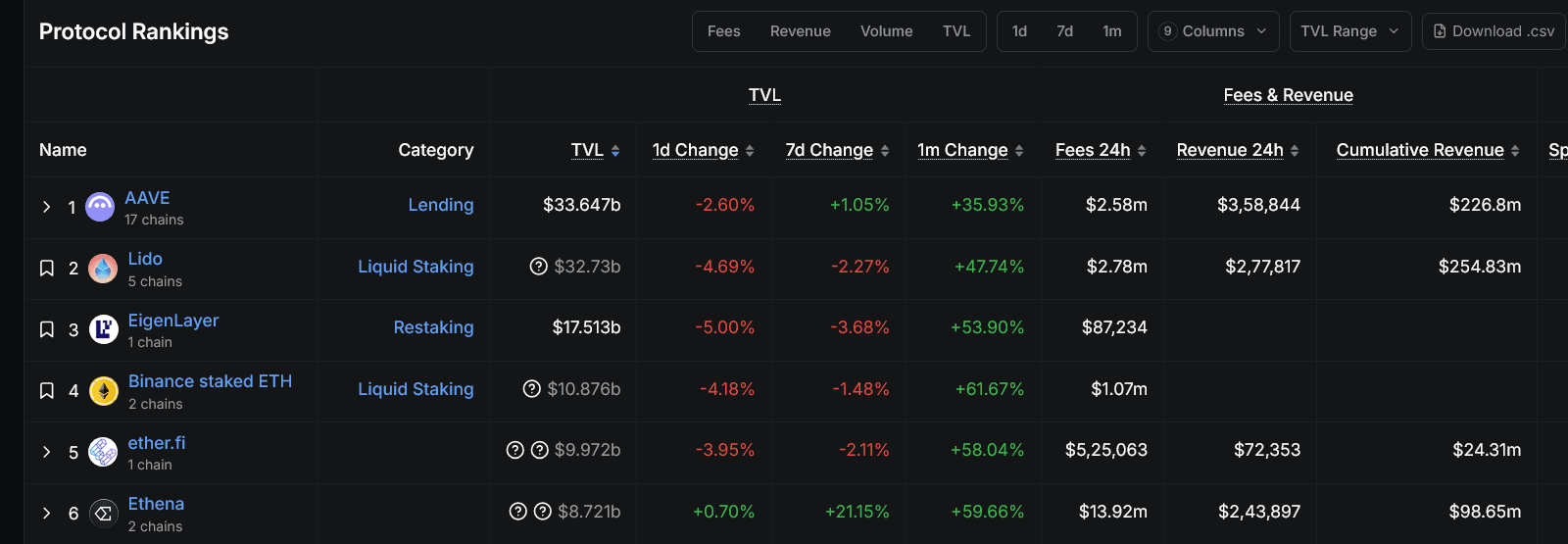The Decentralized Finance (DEFI) market has dumped a total price (TVL) of over $4 billion within a day. Such drops usually surprise people. But zoom out and something more strategic will focus. Data from Defillama reveals not collapse, but a readjustment of protocols, categories, and overall capital flows. Unpack what’s actually going on, what’s important on these charts, and where things are heading next to the crypto market.
The locked total value will hit, but the momentum remains
According to Defilama, TVL across all Defi protocols is currently at $1358.1 billion, a 3.14% drop in the last 24 hours. This shows the prominent DIP of the upward trend that has been building since the second half of 2023. The historic TVL chart shows a clear recovery from the brutal drawdown of 2022, showing much of a stagnation in 2023.
A daily reduction does not change the structure much larger. TVL is still rising significantly annually, and the composition of where the values move is a more useful story than the heading number.
aave, lido and eigenlayer dominate TVL but do not grow

Aave leads with a $33.64 billion TVL across 17 chains. This is almost a quarter of the entire Defi TVL for one protocol. Over the past 24 hours, Aave has dropped 2.6% in locked values, but recorded a modest profit of 1.05% over the week and nearly 36% growth in a month.
Lido, the liquid staking heavyweight, is closely followed at $32.73 billion. The seven-day change is 2.27% negative, but like Aave, it exceeded 47% in the past month. These are big protocols with enormous fluidity. They often act as a source of fluidity or sink during the defi movement of macros.
It then has its tracheal propria, sitting at $175.1 billion. Despite a 5% drop in TVL over the course of the day, it has risen almost 54% this month. That level of volatility suggests volatility on top and shortcomings, suggesting the flow of hot capital.
Ether.fi and Ethena: Outliers that everyone should be seeing
It’s outside of the traditional top three that things get interesting.
Ether.fi has dropped almost 4% that day with TVL at just under $10 billion. Still, it grew by more than 58% last month. It’s a massive relative expansion. What’s even more impressive is the daily charges. It has recorded more than $5.25 million in the last 24 hours. However, revenues are only $72,353, meaning high operating costs or aggressive compensation emissions strategies.
Esena is a wild card. This is the only protocol in the top six, with daily and weekly TVL changes, increasing by 0.7% and 21.15%, respectively. Over the course of a month, 59.66% grew. What’s even more impressive is the 24-hour fee of $1,392 million. It puts it on the top of the revenue leaderboard, far ahead of the lido and aave. The revenues for the day were $2.43 million, reflecting strong actual economic activity, suggesting that tokens are not the only ones that attract liquidity. It appears that Esena is monetizing its real usage.
In short, the data shows that while traditional protocols are slightly more stable or degraded, newer or more agile players like Ether.fi and Ethena are gaining attention and traction quickly.
Price Generation and Real Yield: A New Set of Winners

Overall Defi, the total fee paid over the last 24 hours was $113.9 million. That number should not be underestimated. It reflects that the usage is active even if the TVL drops. In fact, comparing this figure to the DEX volume ($193.8 billion for 24 hours) and the PARP volume ($18.46 billion for 24 hours) highlights the healthy rotation of the Defi overall vertical.
In particular, many users are not just keeping liquidity in safes or LPS. They are actively using trading, bridging, recurring, and leverage. This explains why protocols with lower TVLS (such as Ethena) can outperform high-gross TVL incumbents. Capital is becoming more efficient.
ETF outflow reveals hesitancy or strategic rotation due to institutionality
One Details Shouldn’t Be Ignored: ETF Influx was negative in 24 hours by $97.8 million. It’s not just noise. It shows traditional funds that are slightly drawn back from the crypto wrapper. It is unclear whether the capital is moving to stubcoin, defi protocol, or sitting idols, but the juxtaposition with increased Defi protocol fees suggests that some of it may be spinning on occasions in the chain.
In other words, institutional products are bleeding capital, but native defi protocols may be catching advantages from those flows.
Stablecoin’s fluidity continues to grow quietly
Stubcoins represent dry powder. Their market capitalization now reaches $2669.2 billion, an increase of 0.65% over the past week. That’s the key metric. While TVL for the Defi protocol is declining, the supply of Stablecoin has increased. It suggests that capital is sitting on the sidelines rather than leaving the ecosystem, and is likely waiting for re-entry.
This further supports the idea that 3% TVL drops are not about exits, but about reallocations.
RWA TVL declines, but it’s still important
Real World Assets (RWA) accounts for $12.2 billion in TVL, down 3.15% in a week. This shows something that is in line with the wider decline of TVL, but is worth watching. As Stablecoin Capital began to spin into RWA producing yields, we could see protocols like centrifuges and maple financing start to overdo once more.
So far, the majority of growth this month has been in staking, retour and synthetic dollar protocols.
Over $624 million token unlocks are expected over the next 14 days. It doesn’t always correlate with sales pressure, but it often produces volatility. Projects undergoing large unlocking may see temporary price weaknesses and create entry points for long-term accumulation.
What does this mean for the crypto market?
Short-term TVL drops are no signs of collapse. This is a response to market rotation, unlocking and strategic restructuring across the protocol. Protocols like Ethena and Ether.fi have gained real traction. Their growth in both usage and revenue suggests sustainable momentum rather than fleeting hype. Legacy leaders like Aave and Lido are still strong, but slowing down. These giants could become stable anchors, and new protocols will chase growth. Standard growth and ETF outflows suggest capital movements. The fluidity has not disappeared. You’re waiting for the next wave or entering a more agile strategy. The broader trend remains the same. Zoom out on the TVL chart to see a recovery trend from the early 2023 lows. The current dip fits within that structure.
The market is not broken. It’s breathing. In the next few weeks, it could determine which protocols can translate short-term momentum into long-term domination. For now, Defi looks alive, active, ready for the next move.
$crypto, $cryptomarket, $btc, $aave, $ldo, $ena, $defi, $ethfi



